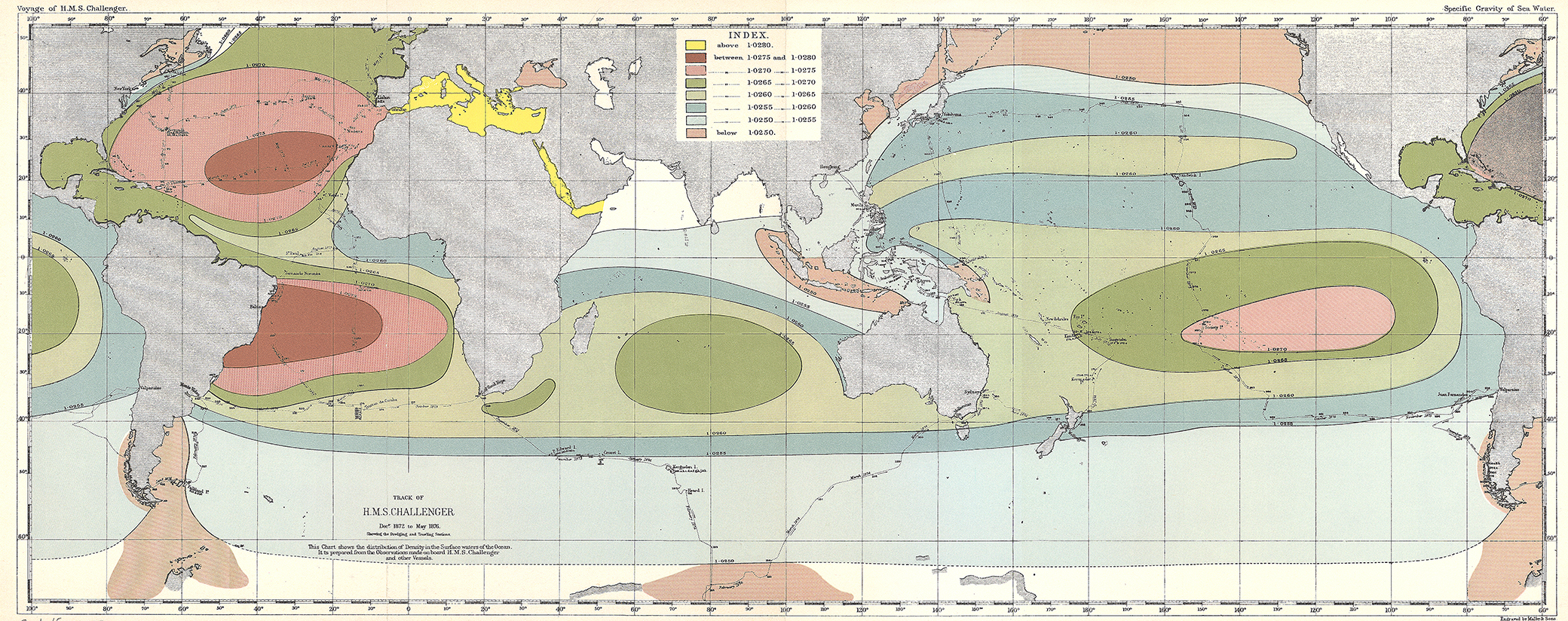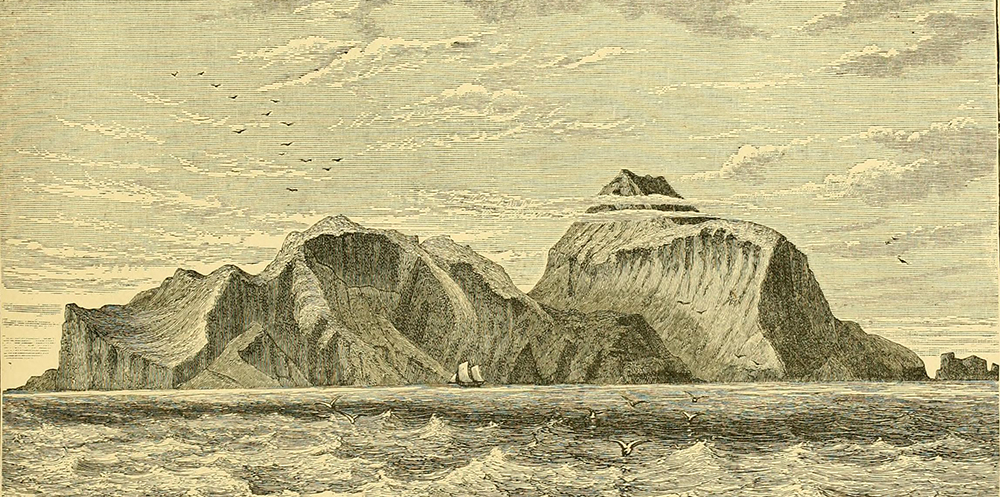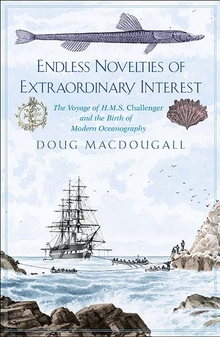
Track of HMS Challenger, c. 1900. Wikimedia Commons, Special Collections of the University of Amsterdam.
Shortly before 8:45 on the evening of December 21, 1872, Phileas Fogg, the hero of Jules Verne’s novel Around the World in Eighty Days, went to his London club to claim a twenty-thousand-pound reward for circumnavigating the world. Months earlier he had made a bet that he could complete the journey in eighty days. None of his friends believed he could do it; they were quite happy to take on a wager they were sure they could win. In fact, at the end of his journey Fogg himself thought he had lost. He had kept careful track of his days, and according to his calculations he was one day late. He was despondent; he had lost the bet by the narrowest of margins. But since this was a novel with a happy ending, it turned out he had missed something: he had forgotten to factor in the international dateline, which he had crossed during his travels, gaining one calendar day. In London it was not the 22nd of December as he believed, but the 21st, and he had indeed completed the journey in eighty days. When he realized this Fogg rushed to his club at the last minute, a happy—and soon to be very rich—man.
In today’s terms his winnings would equal over two million pounds, or roughly three million U.S. dollars. On the same day, December 21, 1872, as the fictitious journey depicted in Verne’s novel came to an end, a real and more momentous voyage around the world was just beginning: the Royal Navy ship HMS Challenger was setting out from Portsmouth—not that far from Phileas Fogg’s London—on what was to be the world’s first major global oceanographic expedition. The crew and scientists aboard Challenger would circumnavigate the globe, as Fogg had done, but their journey would last much longer than eighty days. Challenger did not return to England for more than three years—1,250 days later, to be exact, on Queen Victoria’s birthday, May 24, 1876. By then the ship had crisscrossed the Atlantic, rounded both the Cape of Good Hope and Cape Horn, sailed south toward Antarctica until her way was blocked by ice, and visited numerous remote islands in the Atlantic, Pacific, and Southern Oceans. And it too had crossed the dateline.

When Challenger finally arrived back in England no one on board could claim a monetary reward like Phileas Fogg’s. But for many their experiences on the long voyage were compensation enough. The Challenger expedition was the brainchild of two men who had a common interest in the biology of the oceans and had worked together in the past: Charles Wyville Thomson, professor of natural history at Edinburgh University, and another prominent scientist, William Carpenter, who was based in London. Both were members of the Royal Society, at the time an immensely influential organization, and they submitted their plan for ocean exploration to the Admiralty, which oversaw the navy, under the official auspices of the society. They had a powerful ally in the hydrographer of the navy, a fellow member of the Royal Society, and with surprisingly little hesitation, given the magnitude of the project, the Admiralty agreed to the proposal. In monetary terms the project would turn out to be by far the most expensive single scientific endeavor ever attempted, and it remained one of the largest on record until the mid-twentieth century.
Once it had been agreed that the expedition would proceed, the Royal Society put together a Circumnavigation Committee: a group of prominent scientists whose charge was to set out Challenger’s course and outline the most important tasks she should undertake. It was agreed from the beginning that the voyage was to be dominated by science rather than the needs of the navy, but during the planning stages frequent communication, mostly in the form of written correspondence, passed between the Royal Society and the Admiralty. The Admiralty had questions: What were the “precise objects of research” for the expedition, and “in what particular portions of the ocean” would the investigations “be carried out with the greatest advantage to science?”
The Circumnavigation Committee replied in overwhelming detail, setting out plans for a wide-ranging investigation that would include determining the physical, chemical, and biological characteristics of all the world’s oceans, with special emphasis on the deep sea. The documents submitted to the Admiralty constituted an extensive wish list, the kind of proposal that most scientists today could only dream of. The committee explained at length precisely why certain measurements were necessary and described how they should be carried out. The section of the correspondence that dealt with one small task, the collection of marine algae samples, is a good example. It laid out in excruciating detail the scientific procedure: “The more delicate kinds [of algae], after gentle washing, may be floated in a vessel of fresh water, upon thick and smooth writing or drawing paper; then gently lift out paper and plant together, allow some time to drip then place on the seaweed clean linen or cotton cloth, and on it a sheet of absorbent paper, and submit to moderate pressure—many adhere to paper, but not to cloth; then change the cloth and absorbent paper till the specimens are dry.” We can imagine a dazed Admiralty bureaucrat reading this and wondering what in the world it had to do with naval operations.

The navy was responsible for selecting a vessel for the expedition, and it chose Challenger. Launched in 1858, she was not originally built for science; rather she was a small warship fitted with cannons and designed primarily for duties such as coastal patrols or the support of larger vessels in the fleet. But for her scientific voyage she was refitted and repurposed: onboard laboratories were constructed, accommodation was provided for the civilian scientists, and most of her guns were removed, although two were retained so that ceremonial salutes could be made in foreign ports. (One of the scientists, Henry Moseley, thought this practice was an anachronism. After observing a back-and-forth salute at a Dutch colony in Indonesia he wrote: “It is to be hoped, that before long the intolerable nuisance of saluting will be done away with; it is most astonishing that civilized persons can be so much the slaves of habit, as to make a painful noise of this kind when necessity does not require it; every one concerned dislikes the noise, and there is a great waste of material.”)
William Carpenter and Wyville Thomson were both biologists. Although only Thomson sailed with the expedition—Carpenter remained ashore—both men anticipated that the voyage would result in many new discoveries relating to the flora and fauna of the oceans. They were not disappointed.
The expedition they embarked on was, uniquely, a product of its place and time. In hindsight it is easy to take a historical enterprise like this for granted, as something that was bound to happen. But in its day it was revolutionary.
My first encounter with the Challenger expedition came about serendipitously. I was a new graduate student at the Scripps Institution of Oceanography in La Jolla, California, searching for a suitable PhD research project. I was particularly interested in the sediments of the deep sea floor, and one day in the library, as I glanced at the pile of books I had pulled from the stacks, I noticed one that stood out. It was both larger and older than the others, and the title on the spine said simply Deep-Sea Deposits. Inside I found a more formal and much longer title: Report on Deep-Sea Deposits Based on the Specimens Collected During the Voyage of H.M.S. Challenger During the Years 1872 to 1876. The authors were John Murray and the Reverend A.F. Renard, and the publication date was 1891. The volume was “Published by Order of Her Majesty’s Government,” the title page said. In an editorial note at the beginning of the book, John Murray, the lead author, explained that he hoped the information it contained would be useful because it was “the first attempt to deal systematically with Deep-Sea deposits, and the Geology of the sea bed.” The volume contained hundreds of pages of detailed descriptions of sea-bottom sediments from almost every corner of the world, and the text was accompanied by exquisite drawings of things recovered from the ocean floor: minerals, sharks’ teeth, manganese concretions, shells, and skeletons of creatures such as foraminifera and diatoms.
I was entranced.

The book I was looking at, it turned out, was just one of fifty similarly massive volumes of the Challenger Report. (You read that correctly, there really are fifty.) They comprise the official record of the groundbreaking expedition, detailing its scientific findings and bringing together descriptions of all the specimens recovered. Many scientists, not just the six who had participated in the expedition, were involved in the work that went into producing the report, and the final volume did not appear until 1895, nearly twenty years after the voyage ended. Over the years since my first encounter with these volumes I have periodically returned to them, and to other material related to the expedition. Why such interest in a voyage that took place so long ago? Aside from the science itself—which was certainly important, but to a large degree has been overtaken by modern research—I am fascinated by the question of why the expedition has attained such an iconic place in the annals of ocean exploration and science. Why have so many later vessels of discovery—such as the lunar module piloted by Harrison Schmidt on the Apollo 17 mission and a space shuttle—been named after HMS Challenger? And what was it that compelled those six Challenger scientists to leave their offices, their laboratories, and the comforts of home to embark on such a long and at times difficult sea voyage?
The Challenger expedition was first and foremost about science. But it was funded by the British government through the navy, which turned over one of its vessels to this small group of scientists to sail around the world for several years making measurements and collecting samples of everything from seafloor mud to plants and animals from the islands they visited. Furthermore, the navy provided funds for their salaries as well as for the microscopes, sample jars, dredges, and other pieces of scientific equipment they would need on the voyage. Why? Part of the reason, I believe, had to do with the expedition’s timing. The Victorian era was characterized by curiosity about the natural world—among scientists certainly, but also among the general public. Amateur naturalists abounded: birdwatchers, fossil hunters, butterfly collectors.

An expedition to explore the ocean was almost guaranteed to be a popular venture. That perception was borne out quickly: as the voyage progressed, dispatches from Challenger appeared in newspapers and periodicals worldwide and were eagerly awaited, especially in Britain. When Challenger finally returned home from her epic journey and moored at the navy docks near the mouth of the Thames, so many people wanted to visit the now famous ship that special trains had to be laid on to take passengers from London to the dockyards.
Beyond the intrinsic interest in exploration and discovery, compelling practical considerations came into play when the expedition was first proposed. Britain depended on sea power to guard its global trading routes and protect the far-flung colonies of the British Empire, which were the source of much of the country’s wealth. New information about the vast tracts of ocean patrolled by the Royal Navy would be inherently valuable. In addition, much of the burgeoning business of laying deep sea telegraph cables was centered in Britain, and Challenger’s characterization of the largely unknown deep sea floor would be a boon to that industry. Britain was powerful, supremely confident, and the richest country in the world; the government could afford to mount such an expedition. Not only would it enhance Britain’s reputation as a seagoing nation and supporter of scientific inquiry, it would also have strategic value.
The Challenger expedition was not the first voyage of ocean exploration with a scientific component. British naval voyages, and those of other countries too, often included a naturalist. And for decades, serving officers in the British navy had been tasked with taking measurements of the earth’s magnetic field, recording meteorological data, observing the flora, fauna, and geology of remote lands, and surveying coastlines. Some of these officers had been recognized for their scientific work and became prominent members of the Royal Society. Before the Challenger expedition, however, most of the navy’s peacetime voyages of exploration had been geographically limited and focused on practical or commercial matters, such as surveys of shipping routes, acquisition of new territories, or the search for a northwest passage to the Orient. The scientific observations also concentrated on the practical: magnetism for navigation, flora and fauna as potential food sources, geology for possible mining ventures. But crucially, this meant that the navy and its officers were well prepared for an expedition like that of Challenger, concerned solely with science. By the 1870s there were indications that the United States and Germany in particular were making more ambitious plans for ocean exploration. This, too, was potent motivation for the British government to take on a project like the Challenger expedition. The country could not risk being left behind.

The ambitious plans drawn up for the voyage marked it as the world’s first global oceanographic expedition driven purely by scientific curiosity. The proposed itinerary would take the ship to most parts of the globe, even the Antarctic, and it explicitly included visits to remote oceanic islands and provisions to collect and study samples of rare terrestrial plants and animals. In some ways the expedition was the Apollo project of its day: government-funded “big science” that captured the public imagination. Before 1872, when Challenger set out on her historic journey, the word oceanography did not appear in any dictionary. But by the time the ship returned it was obvious that multidisciplinary study of the oceans was a field of science in its own right.
As Charles Wyville Thomson, the expedition’s scientific leader, wrote in his book Depths of the Sea, the deep ocean was the only remaining place on earth where naturalists could expect to find “endless novelties of extraordinary interest.”
Excerpted from Endless Novelties of Extraordinary Interest: The Voyage of H.M.S. Challenger and the Birth of Modern Oceanography by Doug Macdougall, just published by Yale University Press. Copyright © 2019 by Doug Macdougall. Reprinted by permission of Yale University Press.
